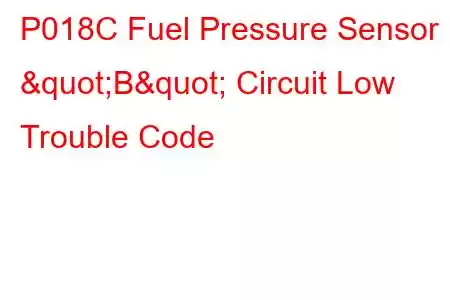P018C Fuel Pressure Sensor B Circuit Low
OBD-II Trouble Code Technical Description
Fuel Pressure Sensor B Circuit Low
What does that mean?
This diagnostic trouble code (DTC) is a generic powertrain code, which means that it applies to OBD-II equipped vehicles that have a fuel pressure sensor (Chevrolet, Ford, GMC, Chrysler, Toyota, etc.). Although generic, the exact repair steps may vary depending on make/model. Anecdotally this code seems a lot more common on GM vehicles (GMC, Chevrolet, etc.) and Dodge / Ram vehicles and may be accompanied with a P018B code and/or other codes at the same time.
Most modern vehicles are equipped with a fuel pressure sensor (FPS). The FPS is one of the main inputs to the powertrain control module (PCM) for fuel pump and/or fuel injector control.
The fuel pressure sensor is a type of sensor called a transducer. This type of sensor varies its internal resistance in relation to pressure. The FPS is typically mounted to either the fuel rail or fuel line. Generally, there are three wires going to the FPS: reference, signal and ground. The sensor receives a reference voltage from the PCM (typically 5-volts) and sends back a return signal voltage that corresponds to fuel pressure.
In the case of this code, the "B" indicates the problem is with a portion of the system circuit, instead of a particular symptom or component.
Code P018C is set when the PCM detects a low fuel pressure sensor signal. This usually indicates the circuit is shorted. Related codes include P018A, P018B, P018D, and P018E.
An example of a fuel pressure sensor:
Code Severity & Symptoms
The severity of these codes is moderate to severe. In some cases, these codes can result in a vehicle that won't start. It's a good idea to address this code as soon as possible.
Symptoms of a P018C trouble code may include:
Illuminated check engine light An engine that is hard to start or does not start Poor engine performanceCommon Causes Of This DTC Code
Possible causes for this code may include:
Faulty fuel pressure sensor Fuel delivery problems Wiring problems Faulty PCMDiagnostic and Repair Procedures
Begin by checking the fuel pressure sensor and corresponding wiring. Look for loose connections, damaged wiring, etc. If damage is found, repair as necessary, clear the code and see if it returns. Next, check for technical service bulletins (TSBs) regarding the issue. If nothing is found, you will need to move forward to step by step diagnosis of the system.
The following is a generalized procedure, as testing for this code varies between vehicles. To accurately test the system, you'll want to refer to the manufacture's diagnostic flow chart.
Check the wiring
Before proceeding, you'll want to consult the factory wiring diagrams to determine which wires are which. Autozone offers free online repair manuals for many vehicles and ALLDATA offers single vehicle subscriptions.
Check the reference voltage portion of the circuit
With the vehicle ignition on, use a digital multimeter set to DC volts to check for reference voltage (usually 5 volts) from the PCM. To do this, connect the negative meter lead to ground and the positive meter lead to the sensor B+ terminal on harness side of the connector. If no reference signal is present, connect the meter set to ohms (with the ignition off) between the reference voltage pin on the fuel pressure sensor and the reference voltage pin on the PCM. If the meter reads out of limits (OL) there is an open circuit between the PCM and sensor that will need to be located and repaired. If the meter reads a numeric value, there is continuity.
If everything is good up to this point, you'll want to check that there is power coming out of the PCM. To do this, turn the ignition on and set the meter to DC volts.
Read: 41


